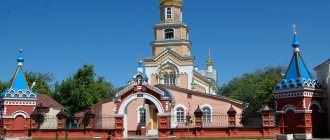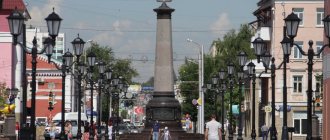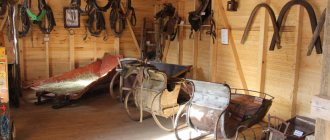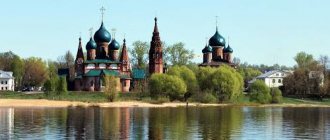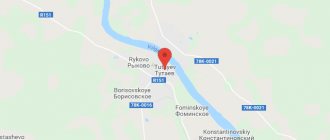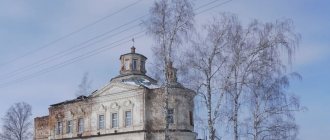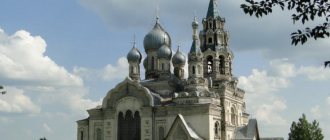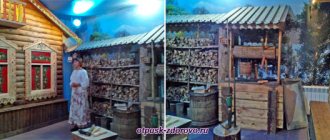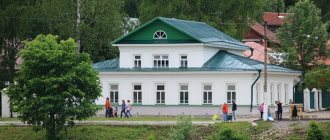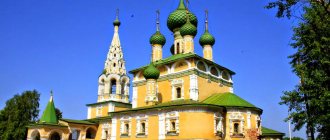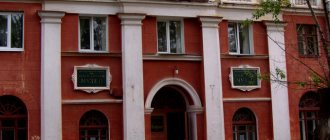Velikoye village, Yaroslavl region. A small settlement with the loud name “Great” is located 41 km from Yaroslavl.
This is one of the oldest villages in the Yaroslavl region. In the Old Russian language the word “great” meant “big”. Nobody knows where such an unusual name of the village came from, there are only different versions. But this is exactly the case when the name hit the target exactly - this village is truly great.
And there is no pathos here, just facts. Why are there so many architectural and historical monuments of federal significance in such a small settlement? In the Middle Ages, this village could rightfully be called the “Great Palace Village”.
Velikoselsky Kremlin
On the shores of the Black Lake, in the very center of the village, the Velikoselsky Kremlin rises. Its uniqueness also lies in the fact that it is the only Kremlin in Russia built not in a city, but in a village. The Kremlin ensemble consists of two churches, a summer church, a winter church and a bell tower, as if connecting both churches.
The first church, the summer one, is the Church of the Nativity of the Blessed Virgin Mary. It was erected in 1712, in memory of the victory over Poltava.
The initiator of its construction was A.I. Repnin. The architecture of the five-domed temple is made in the style of Yaroslavl architecture.
The interior interiors of the church have retained some of the paintings; restoration work is currently underway to completely restore them.
During the revolution, the temple was destroyed and closed, but is currently functioning. The Church of the Intercession of the Blessed Virgin Mary is the winter church of the complex; it was built in 1741. The church was erected through the efforts of the grandson of A.I. Repnin. The architecture of this five-domed church is elegant and sophisticated, with interesting stone architraves. In the 30s of the last century, the church was deprived of its domes and closed; today it is fully functioning, as before.
Being the center of the architectural complex, the bell tower was erected in 1758. The height of the structure is 75 meters, at the base is a massive quadrangle. The bell tower is built of red brick and has seven tiers.
Near the Kremlin you can see a small preserved part of the church fence with corner chapel towers.
Location: Sovetskaya street - 36.
General information
In the 12th-13th centuries, the formation of the Russian state took place and, by the will of fate, the village of Velikoye found itself at the crossroads of those historical events. These events include the princely wars, the battle with the Polish invaders, the Patriotic War of 1812 and other historical events.
Russian tsars, Mikhail Romanov and Peter I, stayed in the village more than once. For participation in the Battle of Poltava, Peter I granted the village of Velikoye to Field Marshal Prince A.I. Repnin. In 1712 A.I. Repnin built the Church of the Nativity of the Virgin Mary in the village. This marked the beginning of the large architectural complex of Velikoselsky, which later became known as the Kremlin. Such a complex will do honor to any capital!
The village of Velikoye was also noted as a large trading center, so already in 1607 it was marked on the geographical map of Russia. In the village there was even a moving palace hut for managing the palace Rostov estates.
All the trading people from the surrounding provinces - Vladimir, Kostroma, Yaroslavl, Vologda - came to the fairs and bazaars in the village of Velikoy. Merchants came from Moscow, Nizhny Novgorod, England and Holland. In the middle of the 19th century, the largest Russian flax factory was located in the village of Velikoy. N.A. wrote about this village. Nekrasov and I.S. Aksakov.
The village of Velikoye also owes its wide popularity in those years to such enlightened people as the nobleman Efim Stepanovich Karnovich and his nephew, historian, writer and publicist - E.P. Karnovich.
During the Soviet years, the village of Velikoye gave the country many military leaders, scientists and prominent government officials. Let's outline the main attractions of this wonderful village.
Mansion A.A. Lokalova
Erected in 1890 by the then quite famous architect F.O. Shekhtel, the mansion of A.A. Lokotova is the most recognizable landmark of the village and an object, although not protected, of cultural heritage.
The building was built in the pseudo-Russian style, which was at the peak of popularity in those years.
The stone mansion has two floors, many decorative elements, tiles and mosaics. This splendor is complemented by twisted semi-columns, high and narrow windows, and a turret topped with a spire.
In the general appearance of the building one can discern not only a pseudo-Russian, but also a pseudo-Gothic style of architecture.
After the revolution, the former mansion housed a museum, and then an orphanage, which is located there to this day. Currently, the dilapidated mansion eloquently requires restoration and reconstruction of full-fledged external and internal decoration.
Review
- The famous Velikoselsky Kremlin
This is a magnificent architectural complex in the center of the village. There is nothing like this in any Russian village! The complex includes two churches, a high seven-tier bell tower, fragments of a surviving protective wall, the remains of shopping arcades and several towers.
In 1712 A.I. Repnin erected the Church of the Nativity of the Virgin Mary in honor of the victory in the Battle of Poltava. The temple was built by local stone craftsmen, and the building materials were also used locally. Later (in the first half of the 18th century), the Intercession Church and the belfry were erected nearby. The construction of this church was carried out by the grandson of A.I. Repnin. One temple was intended for summer services, the other for winter ones. In the Church of the Nativity of the Virgin Mary, wonderful frescoes on the vaults and walls have still survived.
The seven-tiered red brick stone bell tower was built in 1758. Its height is 75 m. This architectural complex suffered its greatest losses after the revolution, during the Soviet era.
Currently, restoration of the Velikoselsky Kremlin is underway.
- Mansion A.A. Lokalova
This mansion was built in 1890 by the son of merchant A.V. Lokalov, owner of the famous Velikoselskaya flax spinning factory. The mansion was built according to the design of the famous architect F.O. Shekhtel.
This magnificent stone two-story building is made in pseudo-Russian style. It is decorated with numerous decorative elements: mosaics, tiles, semi-columns, kokoshniks, high and narrow windows and a turret with a spire. The interior design of the mansion matched its external appearance. The building has survived to this day, but requires restoration. Nowadays this building houses an orphanage.
- House of P.D. Irodova
This is the second stone building built by architect F.O. Shekhtel in the village of Velikoy. It is also an architectural monument of federal significance. Try to find another village where there are stone mansions built by the famous architect F.O. Shekhtel!
- Velikoselsky Local Lore Museum
The museum is located in a two-story stone mansion that once belonged to the merchant Butikov.
In general, this is an ordinary local history museum, the main task of which is to highlight the history of the village of Velikoye. The museum exhibits an interesting collection of antique linen towels, utensils, and personal belongings of residents of the village of Velikoye. From these items you can understand how merchant life and peasant crafts were organized. A separate room is dedicated to the theme of the Soviet period and the Great Patriotic War. The museum also houses paintings and sculptures by local artist A.V. Yashin.
- House number 19 on Yaroslavskaya street
This is a small old stone mansion. There is a memorial plaque on this mansion that says that Tsar Peter I stayed here. Nothing is known about the owner of this house.
- Church of the Bogolyubsk Icon of the Mother of God
Located on the Western outskirts of the village.
It was built in 1847 with donations from parishioners and money from church warden Mikhail Krasheninnikov. It is a stone, one-story, single-domed building with columns and a multi-tiered bell tower. Currently the church is active.
- Church of the Tikhvin Icon of the Mother of God
Located on the northern outskirts of the village. This was also an old brick one-domed altar church. Once upon a time there was an Old Believer church on this site.
In 1861, the Church of the Tikhvin Icon of the Mother of God was erected. Unfortunately, now only ruins remain of it. But even from these ruins one can understand how interesting the architectural style of this church was. I would really like to see it restored.
- Monument to the “Great Villagers” who fell during the Great Patriotic War.
The monument is located next to the Velikoselsky Kremlin. It is a mournful sculpture of a soldier with a machine gun in his hands and wearing a helmet, mounted on a pedestal. The sculpture is very expressive.
Museum of Local Lore
The two-story pink mansion, which previously belonged to the wealthy Velikoselsky merchant Butikov, currently houses the Museum of Local Lore.
Interestingly, the history of the appearance of most of the museum’s exhibits is connected with ordinary village residents who voluntarily brought antiques and family heirlooms here.
The main and permanent exhibitions of the museum tell about: the life of a merchant, the life of village residents of the 19th-20th century, rural crafts, the Soviet period, the time of the Second World War.
The museum displays sculptures and paintings by local talent - artist A. V. Yashin.
Location: Trufanova street - 13.
Black Lake
Since 1985, this lake has been a natural monument. It was around the reservoir, which was, one might say, the heart of the settlement, that the settlements and settlements of the village were built in radial rings. Its waters are replenished by melt and groundwater.
The name of the lake was given due to the fact that previously, according to legend, there were forges along its shores, soot and soot from which gave the water a black color.
In the 19th century, on the initiative of the city doctor I.D. Pisarev's reservoir was thoroughly cleaned of pollution, after which its area decreased somewhat.
Now, unfortunately, no one is doing this. However, Black Lake is definitely worth a look, as it played an important role in the history of the development of the village.
Conclusions and video
It should be noted that at the peak of its heyday (150 years ago), about 5,000 people lived in the village! It looked more like a respectable county town rather than a village.
Another amazing feature of the village of Velikoye can be considered its unusual development. In the center of the village there is Black Lake. All the streets run from the Black Pond in widening rings, which gives the village a unique flavor.
The name of the lake apparently comes from the times when forges and brick factories stood on its shores.
House of P.D. Irodova
This building was also designed by F. O. Shekhtel, this time its architecture is in the Art Nouveau style. The smoothed pseudo-Gothic elements can also be seen in the two-story stone building. The tiles and decorative elements of the roof are very interesting; in general, the house is noticeably different from other buildings in the neighborhood.
It should be noted that two of Shekhtel’s works on a small village indicate that its inhabitants were even richer than in some cities.
The houses of this architect give even a small settlement a special, metropolitan chic. This house is classified as a cultural heritage monument.
Reviews about the village Velikoy
Both in summer and in winter, in any weather, the village of Velikiy, Yaroslavl region, has unique landscapes: the Black Pond, which, by the way, does not look polluted at all, the ancient buildings of the Kremlin.
In the oldest settlement of the Yaroslavl region, which is Velikoye, there are always a lot of tourists. According to reviews, upon closer inspection, the Kremlin no longer makes such a spectacular impression. Buildings are collapsing in places and falling into disrepair. The building needs restoration.
They say that these are quite beautiful, but at the same time strange places. The weather in the village changes extremely quickly, and strange sensations arise during the excursion. But perhaps such emotions are experienced only by extremely impressionable individuals.
House number 19, Yaroslavskaya street
This house is famous for the fact that Peter I once stayed there, as is silently evidenced by the memorial plaque.
It is known that the emperor had a negative attitude towards excessive decoration and decoration, so the house, compact in size, squat, with massive stonework and small windows, was ideal for him to relax.
Most likely, the owner of the house was somehow connected with the emperor, but, unfortunately, nothing is known about this now.
White Lake
The second body of water in the village is called the white lake. In Russia you can find many lakes with a similar name; it was usually given by residents of nearby territories to reservoirs with crystal clear water.
The lake is quite clean and well-groomed; in the summer people go rafting and boating here. Neat and clean wooden walkways lead to the pond. The general atmosphere in this place is peaceful and even somewhat poetic.
Battles in Velikiy
At the end of the fourteenth century, where several cultural and historical monuments are located today, battles took place between Russian warriors and Tatars. In 1425, the Civil War began. In those days, enmity arose between the descendants of Dmitry Donskoy over the Grand Duchy. Major battles were fought by uncooperative relatives halfway between Rostov and Yaroslavl - where today there is a village with an ambiguous name. This event dates back to the 30s of the fifteenth century. And a century and a half later, a battle took place on these lands again, this time between Russian princes and Polish nobles.
At the beginning of the 17th century, the militia of Minin and Pozharsky stayed in the village of Velikiy, Yaroslavl region. They were heading towards Moscow, again to fight the daring Poles who had captured the capital. Local residents treated the liberators very respectfully: they shared provisions, and at night they helped to serve as guards for the vigilantes. Many peasants joined the brave defenders of the Fatherland.
Monument to the Great Villagers who fell during the Great Patriotic War
The monument is a highly artistic sculpture of a soldier in an iron helmet, whose pose speaks of the intense grief that he is experiencing.
The monument is located in the shade of tall fir trees, which emphasize the general atmosphere of sadness and grief. Near the sculpture you can see a plaque with the names of heroes who were born here but gave their lives for victory. The monument is located in a small park, near the rural Kremlin.
Location: street.
Church of the Bogolyubskaya Icon of the Mother of God
In 1846, on the western side of the village, on the initiative of church elder Mikhail Krashennikov, a church was built.
The architecture of the church is made in the style of late classicism, characterized by strict and clear lines, in the absence of unnecessary decorative elements.
The beautiful temple at the village cemetery was destroyed and looted during the years of Soviet power, but is now functioning, restoration work continues to this day. In the ancient cemetery, near which the church is located, you can see ancient church gates and the remains of tombstones.
"Russian rattan"
In the village of Velikoy, Gavrilov-Yamsky district, Yaroslavl region, there is an enterprise that has been widely known in other regions of Russia in recent years. The company was founded not so long ago - in 2012. Manufactures and sells rattan furniture. In the village of Velikoy, Yaroslavl region, equipment for the restaurant and hotel business is manufactured. But not only. The range is quite wide. The company produces furniture sets, kitchen chairs, coffee tables, sofas, chaise lounges, hanging chairs.
The village of Velikoye, Yaroslavl region, is thus famous not only for its unique architectural monuments, but also for its quality furniture. The popularity of the product among restaurant and hotel owners is explained by its low cost. It is not necessary to go to the village of Velikoye, Yaroslavl region, to purchase some furniture. The Russian Rattan online store is open every day, delivery is available. Warehouses are located both in the Yaroslavl region and in Moscow.
